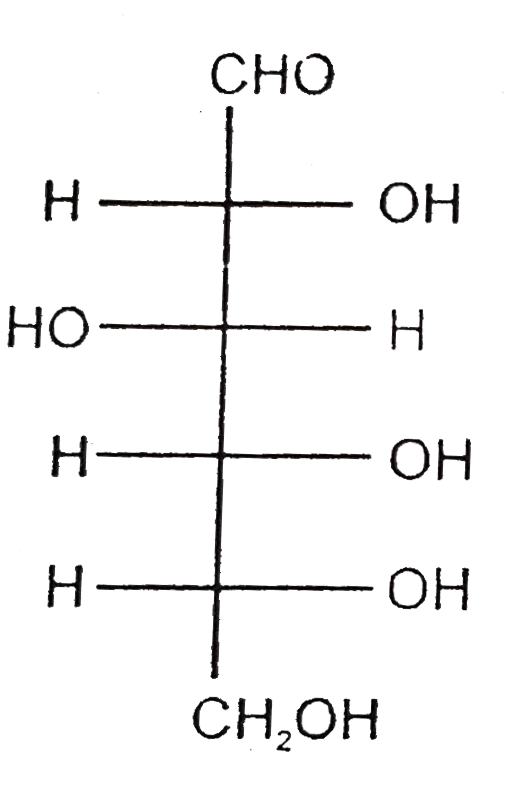Write the chemical reactions of glucose with
(i) (ii) . Also draw Fischer projections of D-glucose and L-glucose.
To solve the question, we will break it down into parts:
Part 1: Chemical Reaction of Glucose with NH2OH
1. Identify the structure of glucose: Glucose is an aldohexose with the molecular formula C6H12O6. Its structure can be represented as:
- CHO (aldehyde group)
- CH2OH (primary alcohol)
- Four CHOH (hydroxyl groups)
2. Reaction with hydroxylamine (NH2OH): When glucose reacts with hydroxylamine, it forms an oxime. The reaction can be represented as follows:
\(
\text{C}_6\text{H}_{12}\text{O}_6 + \text{NH}_2\text{OH} \rightarrow \text{C}_6\text{H}_{11}\text{NO} + \text{H}_2\text{O}
\)
Here, the aldehyde group (CHO) of glucose reacts with hydroxylamine to form a glucose oxime (C6H11NO) and water.
Part 2: Chemical Reaction of Glucose with (CH3CO)2O
1. Identify the structure of acetic anhydride: Acetic anhydride (CH3CO)2O is a reagent used for acetylation.
2. Reaction with acetic anhydride: When glucose reacts with acetic anhydride, it undergoes acetylation, forming glucose pentacetate. The reaction can be represented as follows:
\(
\text{C}_6\text{H}_{12}\text{O}_6 + 5 \text{(CH}_3\text{CO)}_2\text{O} \rightarrow \text{C}_6\text{H}_{10}\text{O}_5\text{(C}_2\text{H}_3\text{O}_2)_5 + 5 \text{CH}_3\text{OH}
\)
In this reaction, each hydroxyl group of glucose is acetylated, resulting in glucose pentacetate and methanol.
Part 3: Fischer Projections of D-Glucose and L-Glucose
1. Draw Fischer projection of D-Glucose:
- The structure of D-glucose can be represented as:
CHO|H−C−OH|HO−C−H|H−C−OH|H−C−OH∣CH2OH
- In D-glucose, the hydroxyl group (-OH) on the last chiral carbon (C5) is on the right side.
2. Draw Fischer projection of L-Glucose:
- The structure of L-glucose can be represented as:
CHO|H−C−OH|HO−C−H|H−C−OH|H−C−OH∣CH2OH
- In L-glucose, the hydroxyl group (-OH) on the last chiral carbon (C5) is on the left side.
Summary of the Solutions:
- Reaction with NH2OH: Glucose + NH2OH → Glucose oxime + H2O
- Reaction with (CH3CO)2O: Glucose + (CH3CO)2O → Glucose pentacetate + CH3OH
- Fischer Projections:
- D-Glucose: -OH on the right at the last chiral carbon.
- L-Glucose: -OH on the left at the last chiral carbon.
1. Identify the structure of glucose: Glucose is an aldohexose with the molecular formula C6H12O6. Its structure can be represented as:
- CHO (aldehyde group)
- CH2OH (primary alcohol)
- Four CHOH (hydroxyl groups)
\(
\text{C}_6\text{H}_{12}\text{O}_6 + \text{NH}_2\text{OH} \rightarrow \text{C}_6\text{H}_{11}\text{NO} + \text{H}_2\text{O}
\)
Here, the aldehyde group (CHO) of glucose reacts with hydroxylamine to form a glucose oxime (C6H11NO) and water.
1. Identify the structure of acetic anhydride: Acetic anhydride (CH3CO)2O is a reagent used for acetylation.
\(
\text{C}_6\text{H}_{12}\text{O}_6 + 5 \text{(CH}_3\text{CO)}_2\text{O} \rightarrow \text{C}_6\text{H}_{10}\text{O}_5\text{(C}_2\text{H}_3\text{O}_2)_5 + 5 \text{CH}_3\text{OH}
\)
In this reaction, each hydroxyl group of glucose is acetylated, resulting in glucose pentacetate and methanol.
1. Draw Fischer projection of D-Glucose:
- The structure of D-glucose can be represented as:
CHO|H−C−OH|HO−C−H|H−C−OH|H−C−OH∣CH2OH
- In D-glucose, the hydroxyl group (-OH) on the last chiral carbon (C5) is on the right side.
- The structure of L-glucose can be represented as:
CHO|H−C−OH|HO−C−H|H−C−OH|H−C−OH∣CH2OH
- In L-glucose, the hydroxyl group (-OH) on the last chiral carbon (C5) is on the left side.
- Reaction with NH2OH: Glucose + NH2OH → Glucose oxime + H2O
- Reaction with (CH3CO)2O: Glucose + (CH3CO)2O → Glucose pentacetate + CH3OH
- Fischer Projections:
- D-Glucose: -OH on the right at the last chiral carbon.
- L-Glucose: -OH on the left at the last chiral carbon.
Topper's Solved these Questions
- BIOMOLECULESBOOK - ICSECHAPTER - BIOMOLECULESEXERCISE - ISC EXAMINATION QUSTIONS (PART-I)(DESCRIPTIVE QUESTIONS)
21 Videos
- BIOMOLECULESBOOK - ICSECHAPTER - BIOMOLECULESEXERCISE - EXERCISE (PART-II) (DESCRIPTIVE QUESTIONS)(SHORT ANSWER QUESTIONS)
67 Videos
- APPENDIX II ( TYPICAL CONVERSIONS)BOOK - ICSECHAPTER - APPENDIX II ( TYPICAL CONVERSIONS)EXERCISE - AROMATIC CONVERSIONS
98 Videos
- CHEMICAL KINETICSBOOK - ICSECHAPTER - CHEMICAL KINETICSEXERCISE - ISC EXAMINATION QUESTIONS (NUMERICAL PROBLEMS )
57 Videos
Similar Questions
Knowledge Check
Glucose on treatment with NH2OH undergoes
AcondensationBreductionChydrolysisDoxidation
Write chemical equations for reaction of acetaldehyde with
NH2OH
View SolutionThe Fischer projection formula of D-glucose is

(i) Give Fischer projection formula of L-glucose
(ii) Give the product of reaction of L-glucose with Tollen's reagent.
View SolutionWrite the reactions of D-glucose which can't be explained by its open chain structure. How can cyclic structure of glucose explain these reactions?
View SolutionWrite the reaction of Mg2+ with Na2HPO4 in presence of NH4 OH and NH4 CI.
View SolutionPhotosysthesis si a bio process by which plants make energy rich molecules from low energy molecules with the help of energy from sunlight . The photosysthesis of glucose can be represented as:
6CO2(g)+6H2Og+hv→C5H12O6(s)+6O2(g)..........(i)
The energy of one mole of a photon of wave lenght is known as one Einstein.
48 Einsteins of 650nm are absorbed by a plant for the production of 1 mole of glucose as given in equation (i). Calculate the % efficiency for the production of glucose by photosynthsis. The energy requried for the formation of 1 mole of glucose is 2870 KJ.
View SolutionFind %w/w of H2O in solution containing glucose with Xglucose=0.1
View SolutionGlucose on reaction with Br2 water gives
View Solution
